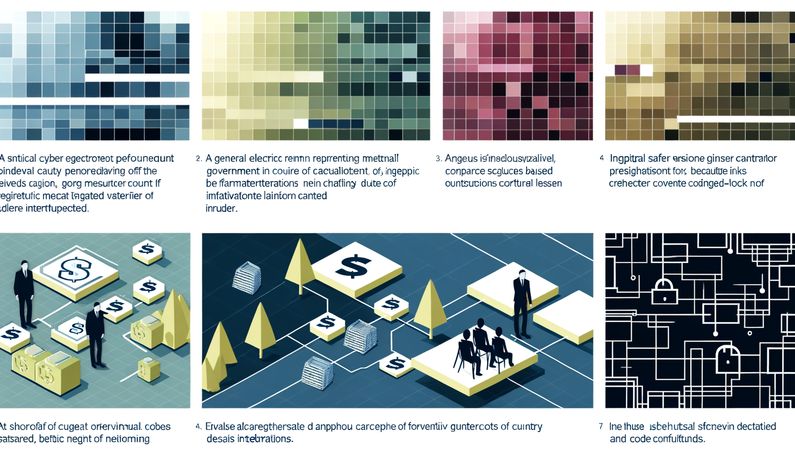
Unraveling the Treasury OCC Cyber Breach: A Deep Dive into the Attack and Its Aftermath
The cyber breach at the Treasury’s Office of the Comptroller of the Currency (OCC) has sent ripples through the cybersecurity community and beyond. Discovered in February 2025, this breach had been stealthily ongoing since June 2023, compromising over 150,000 emails by exploiting an email system administrator’s account. This incident highlights the vulnerabilities within critical financial oversight bodies, such as the OCC, which oversees banks and federal savings associations (BleepingComputer). The attackers, linked to a Chinese state-backed group known as Silk Typhoon, utilized sophisticated techniques, including exploiting command injection vulnerabilities in BeyondTrust’s remote support software (Silverfort). This breach not only underscores the ongoing threat posed by nation-state actors but also the critical need for robust cybersecurity measures and vigilant monitoring of third-party vendor relationships.
Unraveling the Treasury OCC Cyber Breach: A Deep Dive into the Attack and Its Aftermath
Breach Overview and Initial Discovery
The cyber breach at the Treasury’s Office of the Comptroller of the Currency (OCC) came to light in February 2025, although it had been ongoing since June 2023. The attackers gained unauthorized access to over 150,000 emails by compromising an email system administrator’s account. This breach allowed them to monitor communications within the OCC, a critical bureau responsible for overseeing banks and federal savings associations (BleepingComputer).
Initially reported as a “cybersecurity incident” to the U.S. Cybersecurity and Infrastructure Security Agency (CISA), the breach’s severity was underestimated. The OCC initially believed only a limited number of email accounts were affected. However, further investigations revealed that more accounts, including those of around 100 bank regulators, were compromised (BleepingComputer).
Attack Vector and Methodology
The attackers exploited vulnerabilities in the OCC’s email systems, gaining access through a compromised administrative account. This breach was part of a broader campaign that also targeted other Treasury Department systems, including the Office of Foreign Assets Control (OFAC) and the Committee on Foreign Investment in the United States (CFIUS). The attackers used a stolen Remote Support SaaS API key to compromise a BeyondTrust instance, linked to a Chinese state-backed hacking group known as Silk Typhoon (BleepingComputer).
The breach involved sophisticated techniques, including the exploitation of command injection vulnerabilities (CVE-2024-12356 and CVE-2024-12686) in BeyondTrust’s remote support software. These vulnerabilities allowed the attackers to gain unauthorized remote access to Treasury workstations and retrieve unclassified documents (Silverfort).
Impact on Treasury Operations
The breach had significant implications for the Treasury’s operations, particularly in terms of data security and regulatory oversight. The unauthorized access to email accounts and sensitive communications posed a risk to the integrity of the OCC’s regulatory functions. While the breach was reported to have no direct impact on the financial sector, the potential for data leakage and manipulation of regulatory processes raised concerns about the broader implications for financial stability (BleepingComputer).
The Treasury Department’s response involved a comprehensive investigation, analyzing all email logs since 2022 to assess the extent of the breach. The OCC identified and disabled the affected email accounts, but the full scope of the data accessed by the attackers remains unclear (BleepingComputer).
Attribution and Response
The breach was attributed to a Chinese state-sponsored Advanced Persistent Threat (APT) group, highlighting the ongoing cyber threat posed by nation-state actors. The Treasury Department, in collaboration with CISA and the FBI, worked to mitigate the impact of the breach and prevent further unauthorized access. BeyondTrust, the third-party vendor whose software was exploited, took steps to address the vulnerabilities by patching cloud instances and releasing updates for self-hosted versions (TechSpot).
The U.S. government responded by designating Zhou Shuai, a Shanghai-based malicious cyber actor, and his company, Shanghai Heiying Information Technology Company, Limited, for their involvement in the breach. This designation aimed to impose economic sanctions and restrict their access to U.S. financial systems (U.S. Department of the Treasury).
Lessons Learned and Future Preparedness
The Treasury OCC cyber breach underscores the need for robust cybersecurity measures and vigilance against sophisticated cyber threats. The incident highlights the importance of securing third-party vendor relationships and ensuring that vulnerabilities in remote support software are promptly addressed. Organizations must implement comprehensive monitoring and incident response strategies to detect and mitigate breaches early (Wired).
In the aftermath of the breach, the Treasury Department has reinforced its cybersecurity protocols and enhanced collaboration with federal agencies to strengthen its defenses against future attacks. This includes ongoing assessments of potential vulnerabilities and the adoption of advanced security technologies to protect sensitive information (Tom’s Hardware).
The breach also serves as a reminder of the evolving threat landscape and the need for continuous adaptation to emerging cyber threats. By learning from this incident, the Treasury Department aims to bolster its resilience and safeguard its critical operations against future cyberattacks.
Final Thoughts
The Treasury OCC cyber breach serves as a stark reminder of the evolving threat landscape in cybersecurity. The incident, attributed to a Chinese state-sponsored group, underscores the importance of securing third-party vendor relationships and addressing vulnerabilities promptly (TechSpot). The Treasury Department’s response, including enhanced collaboration with federal agencies and reinforcement of cybersecurity protocols, aims to bolster defenses against future attacks (Tom’s Hardware). As organizations continue to navigate this complex landscape, the lessons learned from this breach will be crucial in safeguarding critical operations against emerging cyber threats.
References
- BleepingComputer. (2025). Hackers lurked in Treasury OCC’s systems since June 2023 breach. https://www.bleepingcomputer.com/news/security/hackers-lurked-in-treasury-occs-systems-since-june-2023-breach/
- Silverfort. (2025). The Treasury Department cyberattack: Key insights on BeyondTrust remote support software hack. https://www.silverfort.com/blog/the-treasury-department-cyberattack-key-insights-on-beyondtrust-remote-support-software-hack/
- TechSpot. (2025). Chinese hackers exploit third-party vendor breach in US Treasury cyberattack. https://www.techspot.com/news/106153-chinese-hackers-exploit-third-party-vendor-breach-us.html
- U.S. Department of the Treasury. (2025). Treasury sanctions Chinese cyber actors for malicious cyber activity. https://home.treasury.gov/news/press-releases/sb0042
- Wired. (2025). US Treasury hacked by China. https://www.wired.com/story/us-treasury-hacked-by-china/
- Tom’s Hardware. (2025). Significant U.S. Treasury cybersecurity breach is the latest in string of China hack attacks, claims U.S. officials. https://www.tomshardware.com/tech-industry/cyber-security/significant-u-s-treasury-cybersecurity-breach-is-the-latest-in-string-of-china-hack-attacks-claims-u-s-officials



